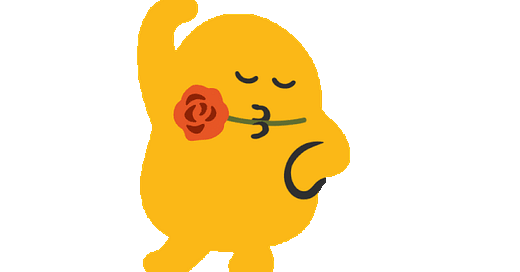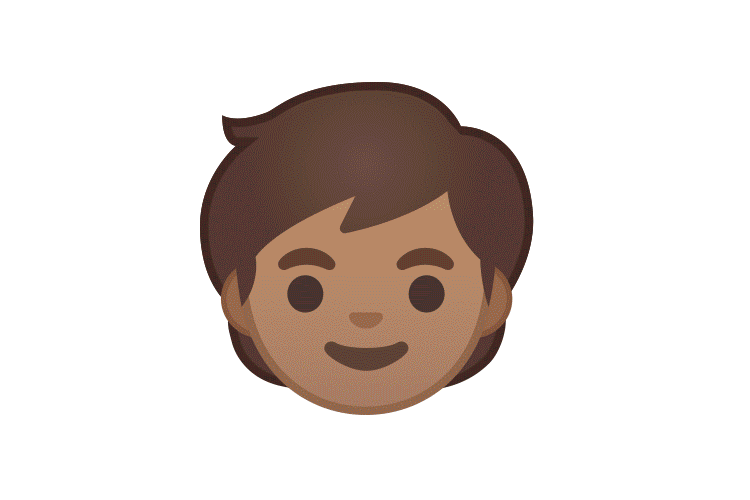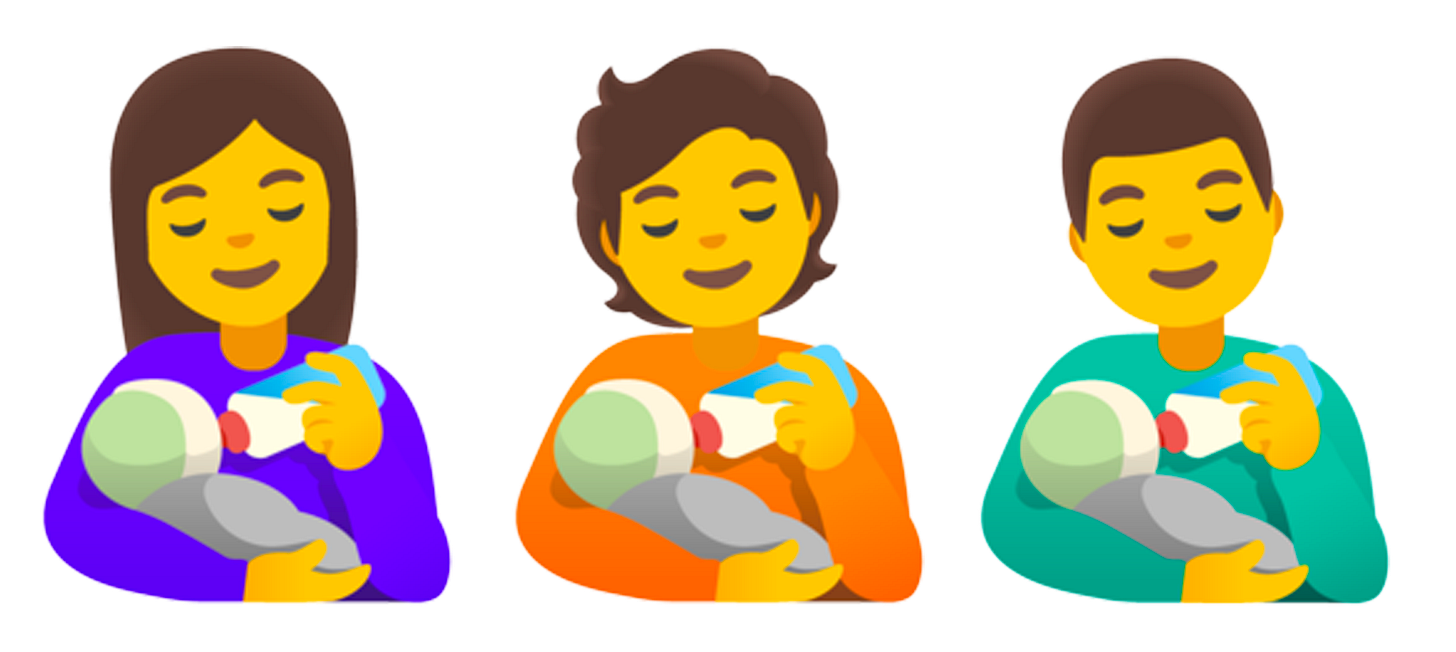Gender, like language, is fluid 〰️
Gender ambiguous emoji shift us away from “heterosexuals are the default" to “here is a family"
This is the *exciting conclusion* to last week’s newsletter which looked at some of the technical challenges facing gender in emoji-form. This week focuses on some of the design considerations. :-)
Given how fluid and dynamic language and gender presentation can be it is remarkable that emoji have kept up with the speed of language online.
Emoji are formal. The internet is informal.
Emoji are relatively stable and “forever”. The internet is hyper-active and transient.
Emoji are broad and abstract. The internet can be very, very specific.
A yin to the other’s yang. ☯️
Regardless of what emoji the Unicode Standard recognizes or how they are designed on Android or iOS it is the people who create language. Storytelling is for everyone — Unicode is just a conduit to scale it. So, when I say the main blocker for supporting gender inclusive emoji was design what I’m really saying is the only thing holding us back was ourselves.
What does it even mean for an emoji to be gender inclusive? Well, sometimes a Doctor is just a Doctor. 🧑⚕️ You could say that a gender inclusive design 'works' if the gender is truly ambiguous to the viewer — if it can represent a person of any gender it has potential to communicate this ambiguity.
Needless to say, accomplishing that is not trivial. Gender is a construct!!!!!! It lives dynamically on a spectrum!!!! Truth be told there is no single visual design “solution”. After all, there is no one way in which a person of any gender can or should present and we wouldn’t want to suggest otherwise.
So, what level of detail is too much or not enough? We set out to identify signifiers that might make something feel either male or female, neither male or female, or both male and female. Keeping in mind that due to each individual’s own perception or ascribing of gender it’s possible people look at the existing “male” emoji and see “woman with short hair” or look at the “female” emoji and see “man with long hair”.

Perception of what smiley can mean also varies depending on demographics. Despite the permanent nature of their technical stability emoji are infinitely flexible linguistically. Emoji have no single meaning and this fluidity is perhaps a reason why they can operate at the speed of language in digital spaces.
Is that “😏” drenched in sexual innuendo or just being smug? Words do a lot of the heavy lifting — 85% of emoji are shared alongside text. But, if no text is present how does one understand what it means? Well, contextual clues such as hearts, tears, or dominant upturned or downturned mouths, etc. are most effective in clarifying meaning provided a conflicting feature is not present.
What is the equivalent for people emoji? Hair? Body language? Facial features? Color of clothing? Shoulders? Accessories? Can you decipher jaw line at emoji sizes???
::Henny Youngman voice:: Take the bathroom symbol. Please.
Specifically, take the symbol on the left. You know the one. The "Men’s Room" sign. On first glance there isn’t much to object to. It effectively reduces the concept of a person to a simple form of physical attributes with no extraneous details. And that’s my point. Nothing indicates that this is supposed to be specifically a man. It could very easily just represent “person” or “all people” if it weren’t for the “Women” symbol directly to the right of it, donning a dress. While we all understand this is just symbolic to differentiate one bathroom from another bathroom— not all women wear skirts and other genders do too — my point is what could've been a perfectly acceptable gender inclusive symbol for “person” instead represents MAN which tbqh symbolically reinforces our man-centered culture. 👀👀👀

Not every woman wears a skirt, not every man has short hair. When designing it’s not always about what details you can see but also what you can’t. The Merperson (below) is designed with crossed arms so their gender remains ambiguous (do I detect a tinge of sass??). The swimmer emoji is wearing a rash-guard. The vampire emoji is wearing a tasteful chain instead of a bow tie or choker. Emoji demand an instant read so sometimes relying on things like clothing, color, and other contextual clues can be useful to at a small size.
Please excuse this brief interruption
A moment of silence for the original gender inclusive emoji: The Blobs.
.
.
.
.
.
.
.
.
.
.
.
.
.
.
.
.
.
.
.
.
.
.
.
.
.
.
.
.
.
.
.
.
.
.
.
.
.
.
.
.
.
.
.
Thank you. (-ω-ゞ
Google’s blob emoji were really something special. Cute, squishy, and remarkably likable … sadly, they were retired before my time. But, fear not! As Noto Emoji get some touch-ups, we’re bringing back what made the Blobs special while simultaneously discarding the parts that weren’t working. Most notably, the blobs’ facial expressions were wildly inconsistent but that’s very easily fixed.
I’m fascinated by the erosion of borders that the blobs operate in. They are evasive and break down our binary way of thinking. They are not feminine nor masculine. Not adult or childlike. Transcend (or exist between?) body and soul. They are ageless, without species, and arguably without race. Concepts such as these were once structured ideals but are now are more fluid than they have traditionally been assumed.
I don’t know what the blobs were … just good little friends. I loved the dancer. I mean look how adorable they are. Not a man. Not a woman. Not an adult. Not a child. They aren’t an animal but also not precisely human either. They’re just cute. Just … a dancer.
And yet … now, we have these ladies. Seeing these before/afters is giving me strong Buss It vibes lolol 💃💃💃💃
It’s important emoji work cross platforms so conforming was inevitable, I guess. But, the original intent of this emoji was to convey the broad concept of dancing. While this flamenco dancer is unquestionably iconic has she also alienated a large number of other kinds of dance?
Onward!
After the “people” emoji landed on keyboards late in 2019 no giant banner emblazoned with, “Mission Accomplished” unfurled. Many emoji were missing gender inclusive equivalents and a dozen emoji remained “explicitly gendered” according to the Unicode Standard.
In some cases, decoupling gender from these concepts was straightforward. 2020 saw the addition of Man in Veil, Woman in Tuxedo, and Mx. Claus. (You may think but there’s no such think as Mx. Claus … but I got bad news. There’s no such thing as Santa Claus.)
Since not having milk-producing breasts doesn’t preclude you from feeding your baby 2020 also brought us three bottle feeding emoji. This was a step in the right direction but there is room for improvement. I have hope that in the future the breastfeeding emoji could be redesigned to be more gender inclusive and removed from the explicitly gendered list.
The latest emoji release (13.1) is actively rolling out now (Google last December, Apple in Beta now) and includes the addition of beard emoji which is useful in a number of ways that you may not expect:
And that brings us to Emoji 14.0 draft candidates. Among them are two people that appear to be very pregnant or very full of food and pair nicely with “Pregnant Woman”. A pregnant person is not just about gender advocacy but also for when you’ve just ate too much at lunch. It’s about understanding the multiple uses of an emoji and despite there being 3,521 of them and the fact that we eat every day until this character there was no satisfactory way of communicating over-eating (but plenty for when you’re hungry).
When there are as many genders as there are people in the world, as many foods as there are ingredients on the planet, and a variety of objects only limited by your imagination, every addition to the emoji palette is at risk of creating zones of exclusion without consciously trying. The best we can do is ensure emoji continue to be as broad, flexible, and fluid as possible. Just like language. Just like you. 🦋
xoxo,
jennifer














